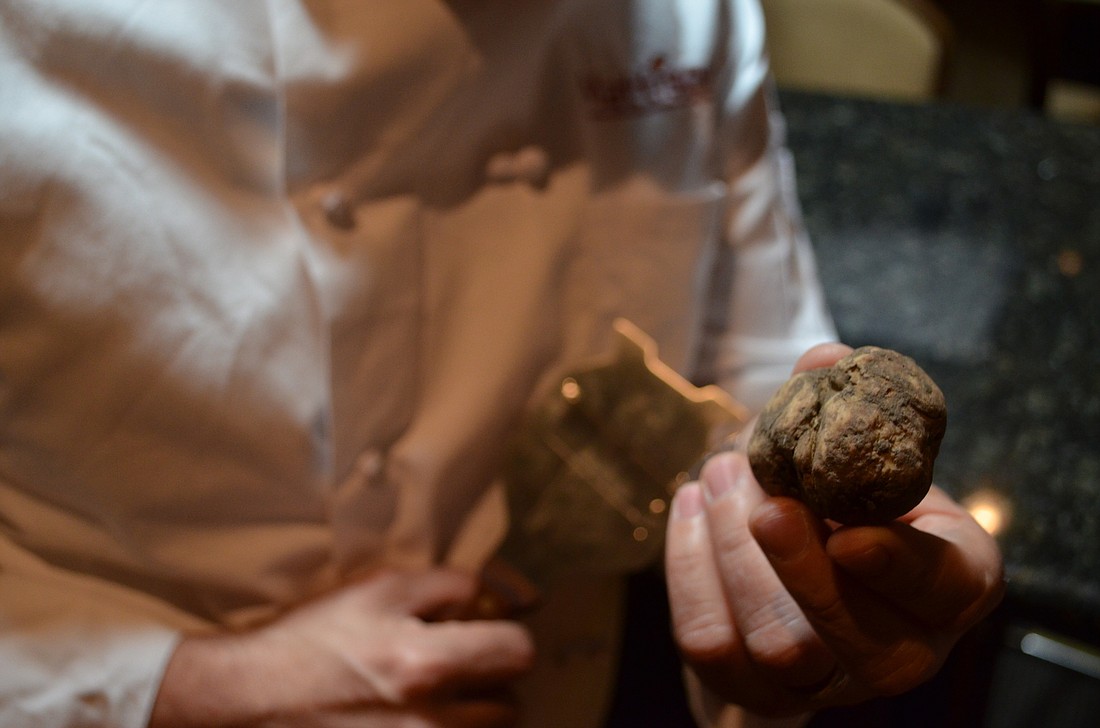- November 26, 2024
-
-
Loading

Loading

At first glance, it doesn’t look like much of anything. Is it a rock? A depressed-looking potato? But if even a pinch of truffle wafts into your nose or is put into a dish, the taste and smell are unmistakable and borderline intoxicating. And for Sarasota chefs Paul Mattison and Chris Covelli, their relationship with this rare member of the fungus family has been love at first bite.
“When you get that first smell or taste, you either become addicted or completely turned off,” says Covelli. “But when its properly prepared and matched with a certain protein it becomes a pure food-gasm.”
This subterranean fungus is the focus of Mattison and Covelli’s annual Wild Truffle Dinner. Entering its fourth year, the dinner has become the kickoff event for the Florida Winefest & Auction’s annual philanthropic food and vino festivities. Celebrating its 25th anniversary, the Florida Winefest & Auction has raised more than $8 million for local children’s charities.
And when truffle nuts Mattison and Covelli wanted to collaborate on this event at Mattison’s Forty-One, they both knew that a dinner focused on an extravagant luxury food needed to serve more than just the duo and their guests’ taste buds.
“We’re buying karma tickets,” says Mattison. “Life is short. You’ve got to share while you can.”
Chefs Mattison and Covelli are preparing a diverse five-course meal to satisfy diehard truffle fans and newcomers alike. The menu includes truffle-infused dishes such as crostini, lobster chowder, halibut potato croquette, smoked duck breast, chianti-braised short ribs and a pineapple poundcake for dessert. The chefs will mix and match white and black truffles in the dishes by shaving thin slices of the truffle’s outer layer and also infusing the interior of the porous ingredient into pastes and sauces. The chefs are spending $2,000 for just over a pound of truffle, which will feed 100 guests.
Rooty Relationship: Truffles can only survive off the roots of a host tree.
Do it in the Dark: Unlike other fungi that reproduce through airborne spores, truffles can only reproduce underground.
Fickle Fungi: Truffles are picky when it comes to their plants. They can only grow on certain kinds of trees, such as oak, hazel, beech, pine and poplar.
EuroTrip: Truffles mainly grow in certain regions of Italy, France and Spain, but in recent years, they've been harvested in Australia and Oregon.
’Tis the Season: Truffles reach peak size and can be harvested between November and February.
Black and White: The two main varieties of truffle, white, from Italy and black, from France and Spain, only differ in one regard: The white has a more powerful punch to the nostrils.
Forbidden Fruit: The truffle is a natural aphrodisiac, and like anything remotely fun, was banned by the Catholic Church in the Middle Ages and the Renaissance.
Big Dig: The record sale for a truffle was $330,000 in 2007 for a white truffle from Italy.
Truffle Stock Market: Like any rare good, the price of truffle rises and falls with supply and demand. Current market price: $6,000 per 2.2 pounds of truffle.
Cuckoo for Cocoa: Contrary to popular belief, real truffles have nothing to do with their chocolate bretheren.
Big Taste, Little Life: After they are pulled from their underground homes, the clock starts ticking on a truffle’s lifespan. It will only remain fresh if kept in cold, dark surroundings.
You break it, you bought it: Truffles are in such high demand on the market that if a truffle hunter makes even a small chip in the flavorful exterior layers, its value drops by at least one-third.
Unlike most food, truffles can’t be grown in a controlled environment or on a farm. They have to be hunted. Each year, Covelli and a team of fellow hunters travel to Tuscany, Italy, to hunt truffles. Armed with just a dog (some truffle hunters prefer using pigs or goats) and a truffle digger, which looks like a hatchet-sized harpoon, the team sets out as early as 3 a.m.
Hunting at dawn keeps the truffles from drying out after being removed from the wet, cold soil. The dog leads them through the forest, and once it picks up the scent under a tree, Covelli and the dog start digging. As the two get closer to the tree’s root system, Covelli starts digging by hand. He doesn’t want his tools or the dog to damage the treasured tuber. After finding the truffle, it’s immediately sealed in a container to retain its flavor, then brought back to the kitchen.